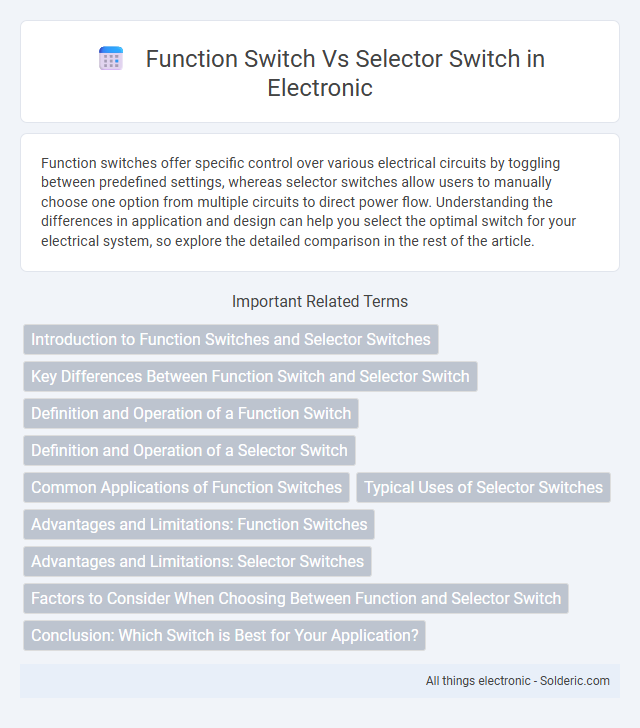Function switches offer specific control over various electrical circuits by toggling between predefined settings, whereas selector switches allow users to manually choose one option from multiple circuits to direct power flow. Understanding the differences in application and design can help you select the optimal switch for your electrical system, so explore the detailed comparison in the rest of the article.
Comparison Table
| Feature | Function Switch | Selector Switch |
|---|---|---|
| Purpose | Executes a specific function based on input | Selects one output from multiple inputs |
| Operation Type | Conditional logic and function execution | Electrical/mechanical position selection |
| Use Case | Programming logic, software flow control | Hardware control, circuit selection |
| Control Method | Software-driven | Manual or mechanical |
| Output | Triggers distinct functions | Connects a single output to selected input |
| Examples | Switch-case statements in code | Multi-position switches in electronics |
Introduction to Function Switches and Selector Switches
Function switches and selector switches serve distinct purposes in electrical control systems, with function switches designed to execute specific tasks or operations automatically, while selector switches allow manual selection between multiple modes or settings. Function switches often have predefined roles, such as activating a motor or lighting circuit, whereas selector switches provide the user with control over different functions or pathways within a device or machinery. Your choice between these switches depends on whether automation or manual control is required in the given application.
Key Differences Between Function Switch and Selector Switch
The key differences between a function switch and a selector switch lie in their operational purpose and design. A function switch typically controls multiple functions within a device by enabling different modes or actions, whereas a selector switch is primarily used to select one option from multiple predefined settings. Your choice depends on whether you need to toggle between specific functions or simply select one setting among various options.
Definition and Operation of a Function Switch
A function switch is an electrical control device designed to select among multiple operation modes or functions within a system by redirecting current flow to specific circuits. It operates through discrete contact positions that correspond to different functions, enabling precise control over system behavior. Unlike a selector switch, which typically provides a simple on/off mechanism or basic circuit selection, a function switch controls complex operational states for diverse applications.
Definition and Operation of a Selector Switch
A selector switch is an electromechanical device used to control different circuit paths by rotating or toggling its lever to a desired position, enabling the selection of various functions or settings within machinery or electrical systems. Unlike function switches, which may only toggle between on and off states, selector switches provide multiple contact points to change operational modes or circuits efficiently. Your ability to fine-tune machine operation increases with the use of selector switches due to their precise positional control and reliable switching mechanism.
Common Applications of Function Switches
Function switches are commonly used in industrial machinery to control specific machine operations such as starting, stopping, or selecting modes in automated systems. They serve in HVAC systems for switching between heating, cooling, and ventilation functions or in control panels for selecting different operational states in manufacturing processes. These switches offer reliable manual control in settings requiring distinct operational commands, enhancing safety and efficiency.
Typical Uses of Selector Switches
Selector switches are commonly used in industrial control panels and machinery to choose between multiple operating modes or control functions, such as start/stop, forward/reverse, or speed settings. These switches provide clear, tactile feedback and allow operators to quickly and safely change system states without complex programming. Your equipment's reliability and ease of use improve significantly when employing selector switches for straightforward control selection tasks.
Advantages and Limitations: Function Switches
Function switches offer precise control in electronic circuits by enabling direct selection and activation of multiple functions through a single interface, enhancing user efficiency and customization. They consume minimal power and provide reliable performance in low-voltage applications, but their complexity can increase with the number of functions, potentially leading to higher costs and maintenance challenges. Limitations include limited scalability for extensive function sets and sensitivity to electrical noise, which can affect switching accuracy in high-frequency environments.
Advantages and Limitations: Selector Switches
Selector switches offer clear advantages such as simplicity, ease of use, and reliability in controlling multiple circuit functions with a single switch, making them ideal for equipment requiring straightforward operational control. Their limitations include restricted functionality in complex systems, as they typically allow only one active position at a time and lack programmability or integration with automated control systems. You should consider these factors when choosing a selector switch, especially if your application demands precise multi-function control or advanced customization.
Factors to Consider When Choosing Between Function and Selector Switch
Consider factors like application complexity, user interaction requirements, and space constraints when choosing between function and selector switches. Function switches offer quick access to specific commands, ideal for straightforward control panels, while selector switches provide multiple positions for more versatile operations. Your decision should prioritize operational clarity and the number of functions needed in your device or system.
Conclusion: Which Switch is Best for Your Application?
Function switches excel in applications requiring multi-level control and complex operations, offering enhanced flexibility and precise function selection. Selector switches provide straightforward, reliable operation ideal for simple on/off or mode-changing tasks with quick user access. Choosing the best switch depends on the complexity of control needed, with function switches suited for intricate processes and selector switches preferred for basic, robust applications.
Function switch vs Selector switch Infographic

 solderic.com
solderic.com